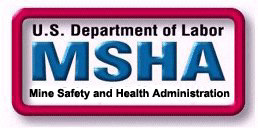
|
MSHA's Occupational Illness and Injury Prevention Program Health Topic "Heat Stress" |  |
|---|
Hot humid weather and hot strata underground are the two main causes of heat stress to miners.
Heat stroke (1), heat exhaustion (2), heat cramps (3), transient heat fatigue (4) and heat rash (5) are the hazards of working in a hot environment.
1. Heat stroke is the most serious health problem associated with work in hot environments. It occurs when the body's temperature regulatory system fails. A heat stroke victim's skin is hot, usually dry, red or spotted. Body temperature is usually 104° Fahrenheit (40° Celsius) or higher and the victim is mentally confused, delirious, perhaps in convulsions, or unconscious. Immediate first-aid and medical care are necessary to prevent permanent brain damage or death. A person with signs or symptoms of heat stroke requires immediate hospitalization. First-aid efforts should be concentrated on lowering the body temperature by loosening tight clothing and soaking the clothing with water, removing the victim to a cool and shady area and fanning the head and upper body vigorously to increase the cooling effect.
2. Heat exhaustion is caused by the loss of large amounts of fluid and electrolytes. A worker suffering from heat exhaustion experiences extreme weakness or fatigue, giddiness, nausea, or headache. The victim may vomit or lose consciousness. The skin is clammy and moist, the complexion is pale or flushed, and the body temperature is normal or only slightly elevated. Rest in a cool place and an ample supply of water or commercially available liquids containing electrolyte is usually all that is needed for a complete recovery.
3. Heat cramps are painful spasms of the muscles that occur among those who sweat profusely, drink large quantities of water, and do not adequately replace the body's electrolyte loss. These cramps may occur during or after work hours and can be relieved by drinking lightly salted liquids or commercially available liquids containing electrolyte. CAUTION--PERSONS WITH HEART PROBLEMS OR THOSE ON A LOW SODIUM DIET WHO WORK IN HOT ENVIRONMENTS SHOULD CONSULT A PHYSICIAN ABOUT WHAT TO DO UNDER THESE CONDITIONS.
4. Workers unaccustomed to heat are particularly susceptible to mental or physiological strain arising from prolonged heat exposure. Therefore, great effort should be made to moderate the heat in the work areas and to minimize the workers' time in hot places. If work in hot places cannot be avoided, then the strain can be minimized if the heat acclimatization is spread overa 5 to 7 day period. With each succeeding daily exposure, the body gradually becomes acclimated to the heat. The key to adaptation is fluid intake--an 8-ounce glassful every quarter-hour, a quart an hour, two gallons during an 8-hour shift.
5. Heat rash, also known as prickly heat, is likely to occur in hot, humid environments where sweat is not easily removed from the skin by evaporation and the skin remains wet most of the time. The sweat ducts become plugged and a skin rash soon appears. Loose garments and good personal hygiene is the best preventative.
If you have any questions about this or any other occupational health matter, feel free to ask us. Our job is protecting your health.
Contact:
Mine Safety and Health Administration
Metal and Nonmetal Health Division
1100 Wilson Boulevard
Arlington, Virginia 22209-3939
Phone: (202) 693-9630